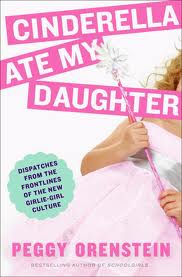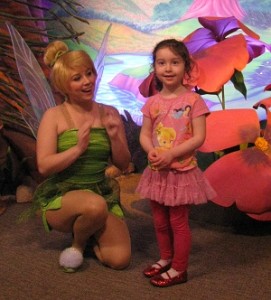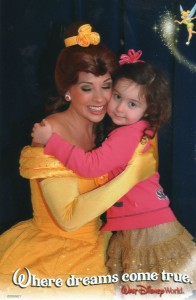Has Cinderella devoured the self-esteem of our daughters? Do young women today have more or fewer options in forging their own identity?
I confess to a great ambivalence about the princess culture that has seized our young girls.
For the most part, when I write a post about a current issue, I have strong opinions on the topic. I’m open to convincing arguments, and reserve the right to change my mind, but I at least begin from a place of some clarity.
This time, wading into sociology and psychology, I am on less certain ground. However, given the implications of body image and self-esteem on academic success, I’m going to move outside of my comfort zone and offer a few thoughts.
With great interest, I picked up Peggy Orenstein’s new book: Cinderella Ate My Daughter: Dispatches from the Front Lines of the New Girlie-Girl Culture.

Although she places herself firmly in the camp of “feminism”, her discussion of the issue is nuanced as she bounces from medical and sociological studies to investigative journalism to her own parenting dilemmas. At one point, she describes her own parenting as sometimes “hypocritical, inconsistent, even reactionary.”
I can relate.
As a former tomboy who preferred climbing trees to dressing up and scraped knees to lip gloss, I am a bit mystified by my own daughter’s seemingly inborn compulsion to dress, decorate, and play entirely in pink. When she was an infant, she wore primarily black, green, and purple. I was not opposed to all things feminine and lovely, however. There were butterflies and dragonflies that floated throughout her jungle-themed nursery. However, the stereotypically frilly was more or less not part of the equation.
Once she could speak, however, everything was pink, tulle, and sugary-sweet.
I recall an episode in which we were selecting a new comb for her curly locks. She made a beeline for a pink comb. I pointed out a green and purple comb, extolling its virtues. For a moment, I thought I had an impact as she picked up the green and purple comb. Then, she handed me the comb and selected the pink one for herself: “Mommy have green comb…and I have pink!”
Pink, of course, is just a color. And one that has not had consistent meaning throughout history and across cultures. As Orenstein points out, pink was once deemed the juvenile version of red and therefore too vibrant for girls and used only for boys.
When moms object to the proliferation of pink, ruffles, heels, and other accoutrement that were once the province of men, therefore, we are really talking not about the objects themselves but rather what they represent–or at least what we fear they represent.
From The New York Times Magazine:
“Playing princess is not the issue,” argues Lyn Mikel Brown, an author, with Sharon Lamb, of “Packaging Girlhood: Rescuing Our Daughters From Marketers’ Schemes.” “The issue is 25,000 Princess products,” says Brown, a professor of education and human development at Colby College. “When one thing is so dominant, then it’s no longer a choice: it’s a mandate, cannibalizing all other forms of play. There’s the illusion of more choices out there for girls, but if you look around, you’ll see their choices are steadily narrowing.”
What Orenstein, and others, are really concerned about is that narrowing of choices, that omnipresence that becomes a mandate, and that standardization of play.
What bothers me is not that my daughter wants to be a fairy princess ballerina–but that she might think there is only one way to act, one way to look, and one way to play.
And even more worrisome is the idea that play, that aspirations, that beauty is not only proscribed–but that it is something you purchase.
Orenstein also visits the child beauty pageants. Predictably, she finds a lot to disparage–but she also finds that she cannot bring herself to judge many of these parents. Those who have very understandable and even sympathetic motives for registering their daughters to compete.
And she describes with stunning insight and empathy the way that it is easy to gradually be drawn in, with tiny little glittery pink, slipper-clad baby steps, to a place you never thought you would find acceptable. Like the frog who sits in the pot as the temperature slowly rises until it is boiled alive, we compromise by small increments.
I know this from my own well-intentioned efforts to preserve my children’s imaginative, childhood play. With my first child, I kept licensed items out of the house. Then, she developed a strong interest in fairies, mystical creatures I’ve always loved myself. The Trojan horse was Tinkerbell. Even in her Neverland incarnation, I adored her. I still clap to revive her at performances of Peter Pan. She and her new crew of Pixie Hollow friends have undergone a Renaissance and are now available on t-shirts, pencils, and just about anything you like.
Once I purchased our first branded item, the floodgates opened. I could no longer hold a hard and fast line with friends and family who wanted to indulge my children. Knowing how much my children love to read, books with all the popular characters came streaming in, followed by plastic toys and movies and more. And, I must confess, I bought a lot of it myself.

Disney is magical. It was a big part of my childhood and I really enjoy a large part of it. The author is good at turning a witty phrase but truly, I do not believe that the moral of Beauty and the Beast is that “the right woman can turn a Beast into a Prince.” Rather, I see it as a tale of a smart and adventurous woman who sees past appearances and whose bravery is the catalyst for fulfilling her own dreams.
Why can’t we just say “yes” to Belle and her intelligence and spirit and “no” to whatever it is we deem inappropriate–low-cut outfits, make-up, $200 accessory packages, or narrow perspectives on femininity.
Part of it is the pervasiveness. While we cannot protect our children forever, we can at an early age. And we can arm them for the future when we cannot. My children do not watch television. They watch a limited amount of video. And while this may sound like a quibble when it comes to the effects of screen-time, it is an important distinction when it comes to holding back the onslaught of marketing.
Still, although my daughter’s desires are not influenced by commercials, they are influenced by her classmates. One little girl brought her American Girl Doll to show and tell and suddenly my daughter’s Christmas wish went from “a package of fairy pencils” to a $200 doll.
Another part of it comes from inside the very parents who are trying to protect their children. The same excuse we hear from pageant parents sounds eerily familiar when it comes from Orenstein–and disturbing when it comes from our own thoughts. We say, “She, our daughter, wants this. She enjoys it so much.”
Even more insidious, we worry about fitting in. If we don’t allow our four year old to go to her friend’s spa party, if we don’t buy our six year old that American Girl Doll so she can play with her friends, if we don’t buy her that commercial princess costume for Halloween–those things she seems to want so badly, completely innocent of what they mean to us–will she be excluded?
If we can say “no” to staying up all night, going out without supervision too young, and too much candy, we should be able to say “no” to the elements of the girlie-girl culture we find objectionable. The fact that we struggle with it shows how wrapped up these issues are in identity and self-esteem.
Ultimately, though, the responsibility lies with us, as parents, to sort through the complex web of marketing, social history, and our personal value systems to decide what is best for our families.
And to maybe acknowledge that sometimes a pink, sparkly dress is not a trap, not a monumental decision fraught with pitfalls, or a symbol of oppression…sometimes it really is just a pink, sparkly dress.

This is such a thought-provoking post Candace. I think you’ve presented the dilemma very well. It’s not a modern one. My son is 23 and I still remember the guilt I felt when I gave in over Teenage Mutant Ninja Turtle books and toys and t-shirts and sheets and…The books were the worst because I love good children’s literature and reading aloud from the “brands” is torture.
As usual, I think it gets back to parental balance. But I strongly believe we should all fight to keep children’s choices open, and not have them forced into moulds designated by manufacturers.
It is good point…and certainly these arguments about the collapse of culture and “kids these days” are seemingly eternal. I think Orenstein would argue, though, that this wave of the commoditization of feminity is both quantitatively and qualitatively different from both the past attempt to limit and codify female roles as well as the current commercialization of boyhood. The sheet volume of products, the push downward in the target age, the invention of the tween, the way the marketing pushes out alternatives, the confusion between how a girl “feels” and how she looks, and the effects (from depression to eating disorders to losing interest in math) are all interesting issues she raises.
One of the things I find so interesting about the book is that she seems to understand that Cinderella isn’t the enemy…but also feels overwhelmed by the constant onslaught she faces as the mother of a daughter. Things that she might have innocently enjoyed appear as part of a slippery slope.
I agree – Orenstein has excellent points.